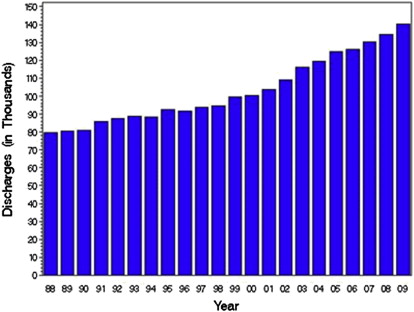Diabetic ketoacidosis epidemiology and demographics
|
Diabetic ketoacidosis Microchapters |
|
Diagnosis |
|---|
|
Treatment |
|
Case Studies |
|
Diabetic ketoacidosis epidemiology and demographics On the Web |
|
American Roentgen Ray Society Images of Diabetic ketoacidosis epidemiology and demographics |
|
Diabetic ketoacidosis epidemiology and demographics in the news |
|
Blogs on Diabetic ketoacidosis epidemiology and demographics |
|
Risk calculators and risk factors for Diabetic ketoacidosis epidemiology and demographics |
Editor-In-Chief: C. Michael Gibson, M.S., M.D. [1]
Please help WikiDoc by adding content here. It's easy! Click here to learn about editing.
Overview
Epidemiology and Demographics
Prevalence
Incidence
- The annual incidence of diabetic ketoacidosis varies in different reports and is related to the geographic location.
- Worldwide, the annual incidence of diabetic ketoacidosis varies from a low of 12.9 persons per 100,000 persons (Denmark) to a high of 26.3 per 100,000 persons (Malaysia).[1][2]
- In the Unites States, the number of hospital discharges with DKA as the first-listed diagnosis increased from about 80,000 discharges in 1988 to about 140,000 in 2009.[3]

Case-fatality rate
- Case-fatality rate of DKA varies from a low of less than 1000 per 100,000 individuals (USA and Scotland) to a high of 30,000 per 100,000 individuals (India).[4]
- Case-fatality rates of DKA differ according to the level of care provided and healthcare setting.[5]
- DKA is the most common cause of death in children and adolescents with type 1 diabetes and accounts for half of all deaths in diabetic patients younger than 24 years of age.[5][6]
Age
- The prevalence of DKA decreases with increasing age.[7]
- In children and adolescents with type 1 diabetes, DKA is the most common cause of death.
- In adult patients, DKA has an overall mortality is <1%.[8]
- In the elderly and in patients with concomitant life-threatening illnesses, the mortality rate is greater than 5%.[9]
- DKA and severe DKA at the time of type 1 diabetes diagnosis have been known to be more common among religious ultra-orthodox than among secular Jewish children, indicating that patient education and awareness of symptoms plays an important role in affecting incidence and prevalence.[10]
Gender
- The prevalence and incidence of DKA is higher in men as compared to women.[7]
Race
- The prevalence and incidence of DKA is higher in non-caucasians than caucasians.[7]
Geographical distribution
- There is marked variability in the incidence of DKA in different parts of the world.
- The frequency of DKA at the time of diagnosis of type 1 diabetes varies across different countries, for example, in United Arab Emirates where it has been reported to be 80% and in Sweden it is 12.8%.[2][11]
References
- ↑ Henriksen OM, Røder ME, Prahl JB, Svendsen OL (2007). "Diabetic ketoacidosis in Denmark Incidence and mortality estimated from public health registries". Diabetes Res. Clin. Pract. 76 (1): 51–6. doi:10.1016/j.diabres.2006.07.024. PMID 16959363.
- ↑ 2.0 2.1 Craig ME, Jones TW, Silink M, Ping YJ (2007). "Diabetes care, glycemic control, and complications in children with type 1 diabetes from Asia and the Western Pacific Region". J. Diabetes Complicat. 21 (5): 280–7. doi:10.1016/j.jdiacomp.2006.04.005. PMID 17825751.
- ↑ "NHDS - National Hospital Discharge Survey Homepage".
- ↑ "Risk of death following admission to a UK hospital with diabetic ketoacidosis | SpringerLink".
- ↑ 5.0 5.1 "Diabetes Care".
- ↑ "DIABETIC KETOACIDOSIS IN CHILDREN - ScienceDirect".
- ↑ 7.0 7.1 7.2 Farsani SF, Brodovicz K, Soleymanlou N, Marquard J, Wissinger E, Maiese BA (2017). "Incidence and prevalence of diabetic ketoacidosis (DKA) among adults with type 1 diabetes mellitus (T1D): a systematic literature review". BMJ Open. 7 (7): e016587. doi:10.1136/bmjopen-2017-016587. PMID 28765134.
- ↑ "NHDS - National Hospital Discharge Survey Homepage".
- ↑ Malone ML, Gennis V, Goodwin JS (1992). "Characteristics of diabetic ketoacidosis in older versus younger adults". J Am Geriatr Soc. 40 (11): 1100–4. PMID 1401693.
- ↑ Gruber N, Reichman B, Lerner-Geva L, Pinhas-Hamiel O (2015). "Increased risk of severe diabetic ketoacidosis among Jewish ultra-orthodox children". Acta Diabetol. 52 (2): 365–71. doi:10.1007/s00592-014-0653-4. PMID 25267080.
- ↑ Samuelsson U, Stenhammar L (2005). "Clinical characteristics at onset of Type 1 diabetes in children diagnosed between 1977 and 2001 in the south-east region of Sweden". Diabetes Res. Clin. Pract. 68 (1): 49–55. doi:10.1016/j.diabres.2004.08.002. PMID 15811565.